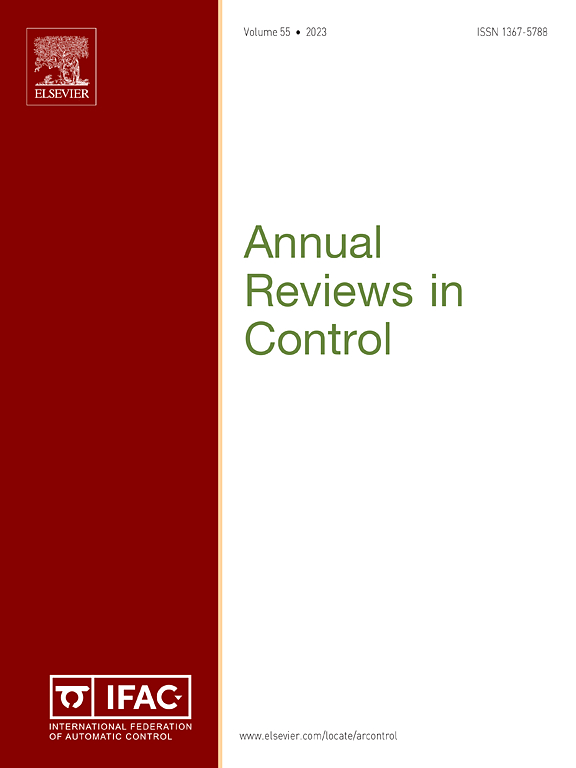Funnel control — A survey
IF 10.7
2区 计算机科学
Q1 AUTOMATION & CONTROL SYSTEMS
引用次数: 0
Abstract
The methodology of funnel control was introduced in the early 2000s, and it has developed since then in many respects achieving a level of mathematical maturity balanced by practical applications. Its fundamental tenet is the attainment of prescribed transient and asymptotic behaviour for continuous-time controlled dynamical processes encompassing linear and nonlinear systems described by functional differential equations, differential–algebraic systems, and partial differential equations. Considered are classes of systems specified only by structural properties – such as relative degree and stable internal dynamics. Prespecified are: a funnel shaped through the choice of a function (absolutely continuous), freely selected by the designer, and a class of (sufficiently smooth) reference signals. The aim is to design a single ‘simple’ feedback strategy (using only input and output information) – called the funnel controller – which, applied to any system of the given class and for any reference signal of the given class, achieves the funnel control objective: that is, the closed-loop system is well-posed in the sense that all signals (both internal and external) are bounded and globally defined, and – most importantly – the error between the system’s output and the reference signal evolves within the prespecified funnel.
The survey is organized as follows. In the Introduction, the genesis of funnel control is outlined via the most simple class of systems: the linear prototype of scalar, single-input, single-output systems. Generalizing the prototype, there follows an exposition of diverse system classes (described by linear, nonlinear, functional, partial differential equations, and differential–algebraic equations) for which funnel control is feasible. The structure and properties of funnel control – in its various guises attuned to available output information – are described and analysed. Up to this point, the treatment is predicated on an implicit assumption that system inputs are unconstrained. Ramifications of input constraints and their incorporation in the funnel methodology are then discussed. Finally, practical applications and implementations of funnel control are highlighted.
漏斗控制——一项调查
漏斗控制方法是在21世纪初引入的,从那时起,它在许多方面得到了发展,在实际应用中达到了数学成熟度的平衡水平。它的基本宗旨是实现规定的瞬态和渐近行为的连续时间控制的动态过程,包括线性和非线性系统描述的泛函微分方程,微分代数系统,和偏微分方程。考虑的是仅由结构特性指定的系统类别-例如相对程度和稳定的内部动力学。预先指定的是:通过选择函数(绝对连续)形成的漏斗,由设计师自由选择,以及一类(足够光滑的)参考信号。目的是设计一个单一的“简单”反馈策略(只使用输入和输出信息)-称为漏斗控制器-它适用于给定类的任何系统和给定类的任何参考信号,实现漏斗控制目标:也就是说,闭环系统在某种意义上是良好的,因为所有信号(内部和外部)都是有界的和全局定义的,最重要的是,系统输出和参考信号之间的误差在预先指定的漏斗内演变。调查安排如下:在引言中,漏斗控制的起源是通过最简单的一类系统来概述的:标量、单输入、单输出系统的线性原型。对原型进行了推广,随后阐述了各种系统类(由线性、非线性、泛函、偏微分方程和微分代数方程描述),其中漏斗控制是可行的。描述和分析了漏斗控制的结构和特性——根据可用的输出信息调整的各种形式。到目前为止,处理是基于一个隐含的假设,即系统输入是不受约束的。然后讨论了输入约束的后果及其在漏斗方法中的结合。最后,重点介绍了漏斗控制的实际应用和实现。
本文章由计算机程序翻译,如有差异,请以英文原文为准。
求助全文
约1分钟内获得全文
求助全文
来源期刊

Annual Reviews in Control
工程技术-自动化与控制系统
CiteScore
19.00
自引率
2.10%
发文量
53
审稿时长
36 days
期刊介绍:
The field of Control is changing very fast now with technology-driven “societal grand challenges” and with the deployment of new digital technologies. The aim of Annual Reviews in Control is to provide comprehensive and visionary views of the field of Control, by publishing the following types of review articles:
Survey Article: Review papers on main methodologies or technical advances adding considerable technical value to the state of the art. Note that papers which purely rely on mechanistic searches and lack comprehensive analysis providing a clear contribution to the field will be rejected.
Vision Article: Cutting-edge and emerging topics with visionary perspective on the future of the field or how it will bridge multiple disciplines, and
Tutorial research Article: Fundamental guides for future studies.
 求助内容:
求助内容: 应助结果提醒方式:
应助结果提醒方式:


